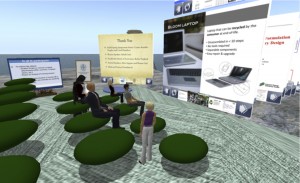
 The following is a special contribution to this blog from Doug Fisher (Vanderbilt University) and Mary Lou Maher (University of Maryland, College Park), who recently co-organized the AAAI 2011 Spring Symposium on Artificial Intelligence and Sustainable Design.
The following is a special contribution to this blog from Doug Fisher (Vanderbilt University) and Mary Lou Maher (University of Maryland, College Park), who recently co-organized the AAAI 2011 Spring Symposium on Artificial Intelligence and Sustainable Design.
About 25-30 people attended the first-ever AAAI Spring Symposium on AI and Sustainable Design held on March 21-23, 2011 at Stanford University. They came from three primary areas:
- AI and Design
- Computational Sustainability
- Design for Sustainability
 There was also a virtual participation option, which was made available to co-authors, colleagues, and students of the authors of the papers as a way of broadening participation without requiring additional travel — and as a result 5-10 avatars attended in Second Life. A total of 18 papers were presented over the course of the two-and-a-half days. Participants also engaged in three separate breakout groups to brainstorm forward-thinking research directions at the intersection of AI and sustainable design.
There was also a virtual participation option, which was made available to co-authors, colleagues, and students of the authors of the papers as a way of broadening participation without requiring additional travel — and as a result 5-10 avatars attended in Second Life. A total of 18 papers were presented over the course of the two-and-a-half days. Participants also engaged in three separate breakout groups to brainstorm forward-thinking research directions at the intersection of AI and sustainable design.
A bit of background: Long-term environmental and societal sustainability requires that artifacts, materials, systems and processes be designed to minimize energy and waste and to maximize reuse and utility; we should hope that the days of designing neat things that are ultimately thrown away are rapidly coming to an end. The ‘design for X’ paradigm considers downstream objectives, such as reusability, early in the design process. Designers are being challenged to consider factors that had been previously given little attention, like life cycle costs along many dimensions; including energy requirements during manufacture, use and end-of-use phases, and material loss and environmental damage at the end of a product’s life. A vision for sustainable design is cradle-to-cradle design (McDonough & Braungart), in which products are designed and built in ways that enable full reuse at low costs (e.g., energy), with nothing thrown out and nothing degraded. Our motivation to organize the workshop stemmed from our presumption that the increased complexity of design necessitated by a desire for very long-term planet sustainability requires application of and advances in artificial intelligence.
AI and design is an established field already, with conferences and journals; AI has provided computational approaches to design processes and the representation of design knowledge. Design for sustainability is not so much a field as it is a set of principles, which are implemented on an ad hoc basis. Computational sustainability is a nascent field, but already influential in moving AI and other computational fields into addressing sustainability questions.
The purpose of this symposium was to focus on domains, problems and challenges of sustainable design and the role that AI can play. On the second day, a session was dedicated to breakout discussion groups, intended to bring out the confluence of ideas that could contribute to a research agenda. Many themes were discussed, including (1) the social computational role of AI in modeling the effect of human behavior on the sustainable design of artifacts and systems; (2) the role of AI in biologically-inspired sustainable design, and (3) the role of customization in fitting designs to individuals and groups in a manner that improves sustainability indices.
The Symposium was successful in achieving a common interest among the participants, which we hope will be maintained through a continued effort to communicate and share research on this topic. Our expectation is that AI will provide formal models, languages and methods of sustainable design, thus helping to push sustainable design from the status of interest area into the status of a discipline.
The Symposium website provides more detail about the papers presented, and the people who participated in planning and presenting: http://www.vuse.vanderbilt.edu/~dfisher/AI-Design-Sustainability.html.










Trackbacks /
Pingbacks